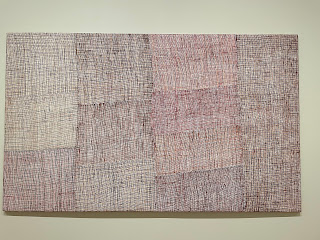On a day when glorious spring in NYC decided to remind about nasty rain and chill I found warmth in MoMa where I went to see the exhibit Woven Histories and Modern Abstractions. "Threads were among the earliest transmitters of meaning", wrote Anni Albers in 1965.
The exhibit starts with these two little pieces by Sonia Delaunay which are fascinating by their simplicity. Here is an old but very interesting piece about her.
Anni Albers has said that "a thread is perhaps the earliest transmitter of the meaning" - I love her work which can be seen in several places through this exhibit.
This Agnes Martin's untitled oil on canvas painting from time when she lived and worked in a loft building in downtown Manhattan with several painters and textile artist Lenore Tawney with whom she developed close personal relationship, mutually informing each other's art practices.
Lenore Tawney Dark Rays - in 1964 Tawney embarked on a series of works on a graph paper that conflate line and thread, drawing and waving.
Interesting work by Gego but hard to photograph it.
I am happy to see Ruth Asawa's works again and again.
After lately seeing so many Yayoi Kusama's colorful polka dotted works this painting was a surprise to me.
Ed Rossbach is well represented in this exhibit.
Venezuelan artist Gego (Gertrud Goldschmidt, 1912-1994) is represented by several very different works in this exhibit. Cut and woven paper strips are something many have done in elementary school as a craft project but this is on such high level.
Another surprise for me was this Ruth Asawa's untitled tempera painting on board.
Ed Rossbach's Tagging Tape Lace - polyethylene
These two colorful works are by Marilou Schultz who is the fourth generation of storied family of Navajo weavers. In 1994 Intel Corporation commissioned her to weave a replica of their Pentium microprocessor using traditional techniques. They used an image of this weaving in a publicity campaign that stressed affinities between Navajo aesthetics and the design of computer hardware. Here she talks about her work.
These Cojini are from a collection of Spanish artist Teresa Lanceta who in the 1980s traveled to Atlas Mountains in Morocco. There she encountered Berber women and learned about their weaving practices.
Jeffrey Gibson is a member of the Missisippi Band of Choctaw Indians and Cherokee. H assemled this ceremonial garment from what he calls a patchwork of materials.
Very mathematical crochet by Andrea Zittel Single Strand Shapes Forward Motion with 90 degree and 180 degree Rotations.(2009) The artist explained that in a series each single strand and shape begins with a set of permissions or rules. There is never a set plan for what the finished work will look like, so all decisions are made in the moment as long as they qualify within the prescribed set of allowed actions.
Just a few "dresses" or wearable (?) art in this exhibit. This one is by Polish artist Paulina Olowska.
More Anni Albers
Hannah Hoch two Embroidery Grid collages
Installation images will give a better feel for this amazing exhibit.































































